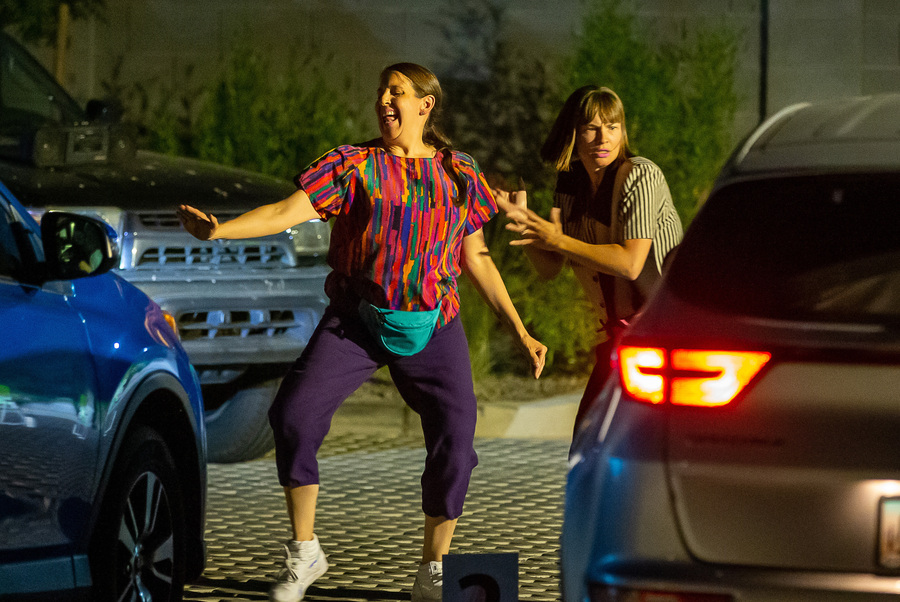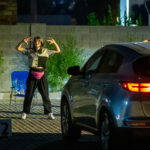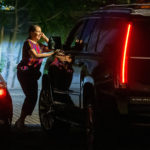With the usual model of theatregoing currently out of the question most everywhere, a handful of theatres have taken a cue from an old concept: medieval pageant wagons. Only this time, instead of the artists driving from audience to audience, the audience drives from artist to artist.
The Alden Theatre in McLean, Va., and the Phoenix-based physical comediennes the Ladies are just two presenters experimenting with this socially distant notion of theatre in a COVID-19 world.
“I just kept feeling like we needed something else,” said Danielle Van Hook, the Alden’s director of youth programs, about the theatre’s original plan to move a play intended for the stage onto Zoom. “I thought about what we would have done 40 years ago, before videoconferencing and cellphones, with similar constraints.”
The Alden is set to debut its “Drive-Thru Drama” performance of Small Change, written and directed by Andrew Scott Zimmer, on July 3. Actors scattered around a parking lot will perform one cohesive story through short solos, each about two minutes long. Audience members will simply roll down their windows and drive from one actor to the next.
Van Hook and Alden performing arts director Sarah N. Schallern Treff decided to stage Small Change in the McLean Community Center parking lot, which has different sections and a natural curve. The actors will be placed along the curving section, which begins about eight parking spots from where the cars will enter.
“I never paid so much attention to what the parking lot design looks like before,” Van Hook said. “A lot of times, when theatremakers work within constraints, you end up making something even more beautiful than you started. But it’s daunting.”
The placement of stop signs, turning-radius-friendly blocking, the feasibility of alternating actors between the cars’ driver and passenger sides, the overall decibel level of up to a dozen vehicles—Van Hook and Treff studied all of these variables, and much more, as they walked through the parking lot. The route will accommodate four cars every 15 minutes, which makes for a performance between 20 and 25 minutes in length.
Many regular theatre conventions are being rewritten for this new format. All auditions and read-throughs will be virtual, and the director and stage manager will meet with only one actor at a time until dress rehearsals. In addition, Treff said, “We’re going to have a no-contact box office as well as a no-contact house manager station. And the curtain speech, rather than saying where the restrooms are, will be to tell patrons to drive five miles an hour and to make sure you put your car in park whenever you’re about to watch a show.”
Zimmer is writing Small Change so that all 10 actors will be performing simultaneously: After the first car sees the first actor perform, the house manager will send it along to the next mini-performance while the first actor starts over with the second car, and so on. “It’s almost like an amusement park ride,” Van Hook said.
She expects the script as well as the logistics to be refined as the run goes along. And it is her hope that this format can come into play even after the coronavirus shutdowns are lifted and audiences can be in close proximity again. Close-up magic, improv, high school drama club fundraisers: These and many other formats, she thinks, could adapt the drive-through performance to their particular needs. “I hope it is something that will live on beyond this time,” she said.
The Ladies, meanwhile, give the impression of living behind their own time: Leanne Schmidt and Marlene Strang, who write and star in their own self-penned comedy material, describe their characters as a pair of awkwardly zany moms who are stuck in the 1990s but are pretty cool nonetheless.
Schmidt and Strang put up their first drive-in performance of Ladies in the Headlights! on April 25. After driving to a secret location “somewhere in Phoenix,” audience members tune into a radio station that the Ladies own, 88.1 FM, to hear the audio. Their headlights serve as the stage lighting for the 15-minute show, and applause is done with car horns.
“The concept is that we are navigating this time in quarantine for the pandemic through this show,” Schmidt said, “so we’re waiting by businesses as if they were going to open.”
Since making their debut in 2017, the Ladies have performed in bookstores, in hotels, and at dinner parties. Once a scheduled April performance in a restaurant was cancelled due to the pandemic, Schmidt said, it took her and Strang only a week to come up with the idea and details of a drive-in performance.
“We are used to coming up with these more unexpected places to perform,” Schmidt said, “so it was already in our bag of tricks to do the drive-in show.”
They search for spaces like off-the-beaten-path parking lots with enough room for five or six cars, which drive through an alley to find the Ladies waiting in the back corner. “We use this to set the mood of the piece and have that connection with the audience,” Strang said. “We think about how we could use the cars to enhance the performance.”
The Ladies is a part-time side gig for Schmidt and Strang, who are both teachers with young kids. They said they are inspired every day by the madness of their current quarantined lives. “Our little monsters, our darlings, are such a huge part of our artistic lives,” Strang said. “We draw inspiration for our work from being a mom, from being a homemaker, from being a Lady.”
Their work before COVID-19 was very social. Past productions involved getting the audience to help create the work as well as the environment. With Ladies in the Headlights!, Schmidt and Strang try to help audience members connect to one another and the performers within the constraints of social distancing. They have played with receiving feedback via horns and even windshield wipers.
“Art is viewed so differently when it’s live,” Schmidt said. “We received feedback that the audience has been able to experience each other, which is something very important to us, especially in the current times.”
Utkarsha Laharia is a Goldring Arts Journalism graduate student at Syracuse University.




